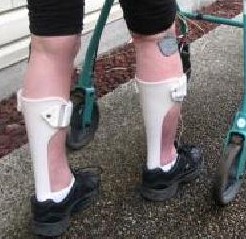As reported in an earlier blog – dropped foot stimulation can significantly increase walking speed in stroke patients. Walking speed in stroke patients shows a wide variation depending on a # o…
Gait technology should be considered at any time post stroke to improve walking ability particularly where traditional rehabilitation approaches have not been successful in restoring a safe, functiona…

In patients post stroke or post onset of MS who demonstrate ankle dorsiflexion with preserved tibilais anterior function the principal gait deficit may be loss of ankle eversion due to peroneus longu…

Flexion synergy in the stroke patient makes voluntary elbow extension difficult or impossible. Activation of the triceps with electrical stimulation when a flexion synergy is present can be a means of…
Electrical stimulation applied to the triceps muscle post stroke is useful to address a number of treatment goals including: preservation of elbow range of motion/prevention of biceps contracture, mot…
In post stroke gait – loss of ankle eversion can be a significant impediment to independent, safe gait as placement of the foot in a plantagrade position for weight bearing is lost. Loss of …

A 1999 study on stroke gait by Taylor et al., reported a mean 20 % gait speed increase in hemiplegic patients with use of the Odstock Dropped Foot Stimulator (ODFS). This finding has been supported in…

2 channel neuromuscular stimulation can be an effective intervention to reduce shoulder subluxation post stroke. Stimulation Delivery & Electrode Placement: Using the overlapping mode of …

A common assumption may be that fitting an ankle foot orthosis (AFO) is sufficient to address walking difficulty after neurologic impairment such as stroke, MS, traumatic brain or spinal cord injury…

In some individuals, MS may result in weakness of the lower limb (leg) muscles and difficulty with walking, Decreased walking endurance may also limit ability to walk even short distances out of doo…